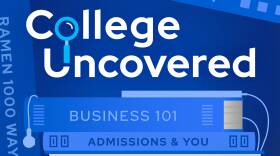Harvard community protests Trump's move to strip tax-exempt status, student visas
The White House is trying to strip Harvard’s tax-exempt status and its ability to enroll foreign students.
Podcast: College Uncovered
-
S3 Eps 4 - The Rural Higher Education Blues
Delta State University in rural Mississippi eliminated it’s highly regarded music department. It’ also cut English, math, chemistry, and about a third of the courses that it used to teach.And Delta State’s far from alone. Arkansas State, the University of North Carolina – Greensboro, Youngstown State in Ohio, West Virginia University have all made significant course cutbacks.That’s a problem. People in rural America already have far less access to colleges and universities than people in cities and suburbs. Nearly 13 million people in the US already live in higher education desserts, places well beyond commuting distance to a college.But now many of the schools that exist to serve rural students are cutting programs and majors.We talk about this trend, and how it exacerbates the already wide economic, social and political divisions between many rural and urban Americans. -
S3 Eps 3 - The Borrowers’ Lament
More than 40 million Americans have student loan debt, but should the government forgive all or part of it? It’s a debate that’s a source of extreme political division. Opponents call it a transfer of wealth from the bottom of the socioeconomic ladder to the top and people with college degrees; supporters say forgiveness gives some breathing room to graduates who are being crushed by the costs of repayment, in some cases without ever even having graduated. The cost of college is also forcing people to put off marriage, starting families, or buying a house and fuel the American economy. We’ll hear from student loan holders and get advice on how to avoid going into debt in the first place. -
S3 Eps2 - The politics of protest
Following intense, sometimes violent protests on college campuses last spring, colleges are taking new steps to encourage more civil dialogue and debate among students who disagree. Some schools are offering new guidance and coursework around how students should speak to one another in an effort to bridge deep differences. At the same time, colleges are tightening restrictions on campus protests related to the war in Gaza, and cracking down on protest tactics with heightened enforcement. We’ll explore the new approaches and talk with experts about the efforts to help students speak across their differences. -
S3 Eps 1 - Un-welcome to college
Divisive protests, police crackdowns, and a chilling backlash against free speech are among the reasons that a growing number of students say they don’t feel welcome on some college campuses. Conflicts over abortion, LGBTQ+ rights, and DEI, as well as what can and can’t be taught in classrooms are stirring up campus life against the backdrop of a contentious presidential election. A majority of students say abortion laws and restrictions around the discussion of race and gender would have at least some effect on where they go to college, according to Gallup polling. The same polls also find that some students at four-year universities feel as if they don’t belong or disrespected.Students on the left and right alike say they’re increasingly reluctant to express controversial opinions, but that it’s okay to report on classmates or faculty who do. That’s why we’re exploring the politics of higher education this season. College has become a new battleground in the culture wars, and it's affecting where students enroll and what they’re learning. Learn more from the Hechinger Report's College Welcome Guide! -
Election Year Edition: The Politics of College
College Uncovered Season 3 is coming! First episode drops on Thursday, September 12th. In our first two seasons, GBH and The Hechinger Report explored the business of college admissions and paying for your education. Now we’re back with a special election year season, helping you navigate the politics of American colleges and universities.College Uncovered is hosted by Kirk Carapezza and Jon Marcus, journalists with decades of experience who specialize in covering higher education in the U.S. They offer students and their families an unvarnished look at a uniquely American system, so YOU can make fully informed choices.One episode will drop weekly and will be available wherever you listen to podcasts.













